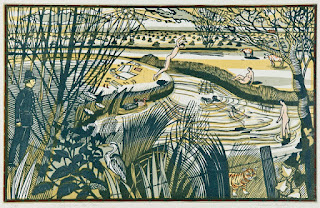Each of Edward Bawden's prints present two different types of compositions; one is of lofty open-aired spaces, and the other is a sort of down and dirty, in the trenches sort of place. We are a part of the nameless, and often faceless, working classes who toil each day to bring us our goods at the market, and swimmingly maneuver through the chaos of urban settings, transporting goods and livestock to market.
Bawden presents these dual compositions effortlessly. We are always looking up at the architectural grandeur of the spaces he presents, and then secondarily notice the lower(smaller) group of people walking with carts through a maze of crowded streets, or quietly, mindfully stocking their booths for the daily markets in anticipation of a good day's sales.
These colorful prints are full of lightness and optimism, maybe in the mindset that hard work will produce good business and lots of $$$. The neatness of his lines and overlapping characters is busy, yet never chaotic. These are well thought out compositions and one can easily imagine the sounds and smells that his scenes would produce. His work honors the working class' contributuions to a well-run society in a positive and methodic manner.
Edward Bawden, CBE RA (1903–1989) was an English artist known for his paintings, illustrations, graphic prints, book covers, posters, and garden metalwork furniture.
He taught at the Royal College of Art, where he had been a student, worked as a commercial artist and served as a war artist in World War II. He was a fine watercolor painter but worked in many different media. He illustrated several books and painted murals in both the 1930s and 1960s.
Bawden was born at Braintree, in Essex. He was an only child, and spent much of his time drawing or wandering the countryside with his butterfly-net and microscope. He studied at Braintree High School, and began copying drawings of cats and illustrations from boys' and girls' magazines. Later he attended the Friends' School at Saffron Walden, and there, he was recommended to study at the Cambridge School of Art, which he attended from 1919 to 1921.
He became interested in calligraphy and in the work of Aubrey Beardsley, Richard Doyle, William Morris and other artists of the day. In 1922 he received a scholarship to the Royal College of Art School of Design in London, where he earned a diploma in illustration.
By 1930 Bawden started working for Curwen Press, producing illustrations for clients such as London Transport, Westminster Bank, Twinings, Poole Potteries, Shell-Mex, the Folio Society, Chatto & Windus, and Penguin Books. In the early 1930s he was discovered by the Stuart Advertising Agency. Around this time Bawden produced some of his most humorous and innovative work for Fortnum & Mason and Imperial Airways. He also worked for The Listener.
Most of his subjects were of scenes around Great Bardfield. In 1938 he collaborated with John Aldridge on a range of wallpapers that they intended to be printed commercially. The project left little time for other work during the year, and war intervened before the wallpapers could go into production.
During World War II, Bawden served as an official war artist, first with the British army in France and then in the Middle East. He was posted to North Africa as a War Office Artist. He painted landscapes and portraits in Libya, Sudan, Cairo, Eritrea and Ethiopia, Palestine and Lebanon.
After making a series of studies of the Marsh Arabs in southern Iraq, he was recalled to London. After the ship he took sank, he was held prisoner in a Vichy internment camp in Casablanca for two months before the camp was liberated by American troops. When he eventually returned to Britain, Bawden did portrait work. He returned to the Middle east in September 1943, as a Ministry of Information artist to work in Baghdad and Kurdistan, before he joined the Middle East Anti-Locust Unit; where he traveled to southern Iraq and Iran.
Bawden returned to England in 1944 for a short time before traveling to Yugoslavia, by way of Rome. He went to Ravenna, then Greece, Austria and Florence before travelling back to England in July 1945. Helived in Great Bardfield, Essex from the 1930s to 1970. While living at Bardfield he was an important member of the Great Bardfield Artists; a group who shared a love for figurative art. He continued with his illustrations, completed a series of eleven murals for the First Class lounge of the P&O liner Oronsay and participated in a series of traveling exhibits. From 1970 to1989, Bawden moved to Saffron Walden, where he continued to work until his death.
Public Collections:
Fry Art Gallery
The Higgins Art Gallery & Museum, Bedford
London Underground commission
Morley College mural
Mural for Queen's University, Belfast
Teaching:
Goldsmiths, University of London
Royal College of Art
Royal Academy Schools
Senior Lecturer at Leicester College of Art and Design
Honors:
1946 – Awarded CBE (Commander of the Order of the British Empire)
1947 – Associate of the Royal Academy
1949 – Royal Designer for Industry (RSA)
1949/50 – Guest instructor at the Banff School of Fine Art, Canada
1951 – Trustee of the Tate Gallery
1956 – Elected Royal Academician
1962 – Honorary Associate of Manchester College of Art
1963 – Honorary Fellow of the Royal College of Art
1964 – Silver Medal from the Society of Industrial Artists
1970 – Honorary Doctorate from the Royal College of Art
1974 – Honorary Doctorate from the University of Essex
1979 – Honorary Fellow of the Royal Society of Painter-Etchers and Engravers












No comments:
Post a Comment